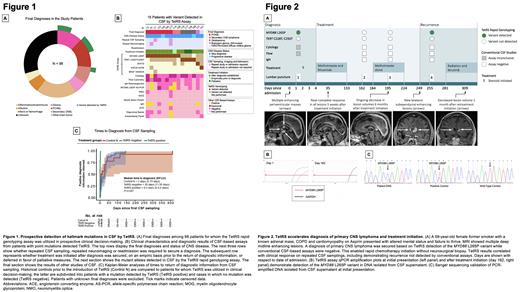Abstract
The overlapping clinical and radiographic features of CNS neoplasms, combined with low yields of conventional CSF studies, complicate diagnostic workflows and delay treatment initiation. Neurosurgical biopsies of high-risk lesions are frequently required, and decisions regarding extent of surgical resection are challenging. In order to address these challenges, we previously developed the Targeted Rapid Sequencing (TetRS) assay to detect highly recurrent point mutations characteristic of CNS neoplasms from CSF, within 80 minutes of sample collection. This qPCR-based panel offers parallel detection of MYD88, TERT promoter, IDH1/2, BRAF and H3F3A point mutations.
In this study, we describe the clinical performance and real-time utilization of this assay in a large, single-center prospective patient sample. We asked whether rapid point mutation detection from CSF liquid biopsies can (1) accelerate times to diagnosis and (2) provide a basis for safely initiating disease-directed therapies in the absence of solid tissue sampling. We collected CSF from 98 patients with new CNS lesions suspicious for neoplasms over an 18-month period. Patient enrollment, selection of specific assay variants, and utilization of results in clinical decision-making were at the discretion of providing physicians. IRB approval was obtained.
In this diverse cohort, 40 of 98 patients ultimately established a diagnosis of a CNS neoplasm. A point mutation was detected by TetRS in 15 out of 40 patients with a neoplasm (37.5%); this included cases of primary and secondary CNS lymphoma (PCNSL), glioblastoma, IDH-mutant brainstem glioma and H3K27M-mutant diffuse midline glioma. In time-to-event analyses, we found that detection of a mutation by TetRS accelerated the return of diagnostic information from CSF sampling when compared to contemporaneous and historical control cases in which a mutation was not detected (median 0.5 vs 10.5 days, P<0.01).
We found multiple cases in which mutation detection by TetRS helped to avoid neurosurgical biopsy. In one representative case, detection of the MYD88 L265P mutation established the diagnosis of PCNSL; methotrexate and rituximab were initiated within 3 days of CSF sampling. In this patient, TetRS results over serial CSF samplings correlated with treatment response and detecting disease recurrence. In another representative case, a lesion initially thought to be an H3K27M-mutant diffuse midline glioma on clinical and radiographic grounds was instead diagnosed as an IDH-mutant brainstem glioma based on TetRS detection of the IDH1 R132G mutation in CSF. This enabled rapid initiation of fractionated radiation, as well as targeted IDH inhibitor therapy; the patient experienced clinical and radiographic response over 10 months of follow-up.
TetRS thus represents a novel, targeted point mutation panel that can rapidly and specifically diagnose a broad array of CNS neoplasms. We demonstrate the potential of this novel tool to accelerate diagnosis, follow treatment response and detect recurrence in selected patients without solid tissue sampling.
Disclosures
Cahill:Dr. Daniel Cahill: Patents & Royalties: (Patent #US20170369939A1). Shankar:Dr. Ganesh Shankar: Patents & Royalties: (Patent #US20170369939A1).
Author notes
Asterisk with author names denotes non-ASH members.


This feature is available to Subscribers Only
Sign In or Create an Account Close Modal